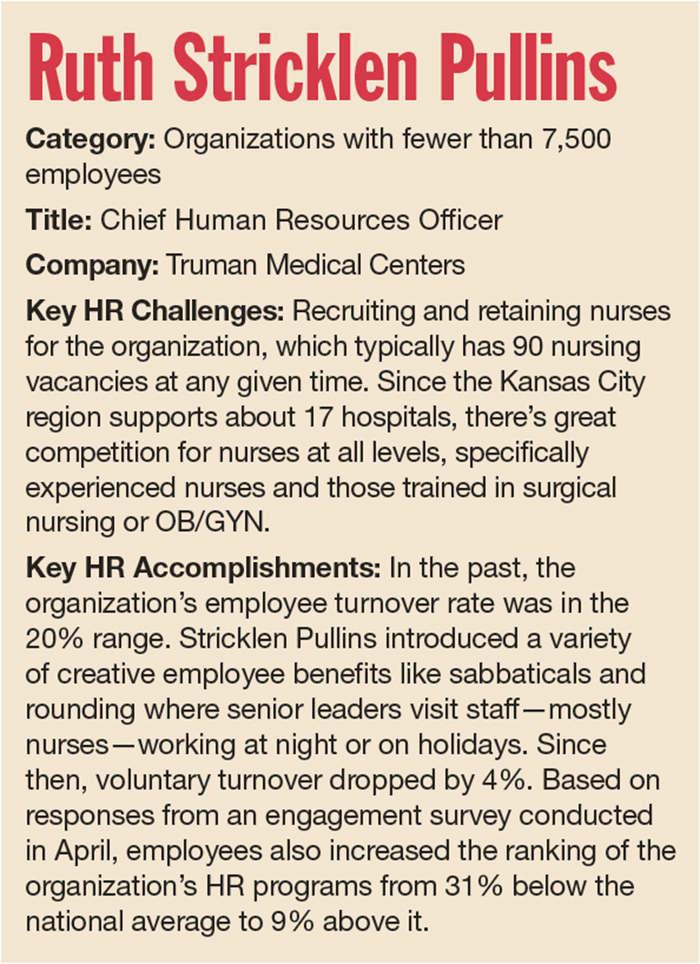Ruth Stricklen Pullins, CHRO at Truman Medical Centers in Kansas City, Mo., envisions her HR role as a differentiator, someone who breaks ground by introducing different or creative workplace ideas, mainly surrounding employee benefits.
While in her current position for nearly four years, she has introduced a series of benefits that serve as effective recruitment and retention tools, as well as morale and engagement boosters, for TMC’s 4,500 employees. The organization supports two acute-care academic hospitals, a behavioral-health program, a long-term-care facility and multiple primary-care practices.
Read more: This leader was named HR Executive of the Year
Under her guidance, HR introduced TruRenewal in 2017, a paid sabbatical program aimed at the organization’s approximately 150 directors and executives. Once every five years, they can take up to eight weeks off by combining PTO–between two and four weeks–with up to four weeks contributed by TMC.
Although there are no restrictions on how participants spend their time, they must complete a pre- and post-assessment survey about their stress levels, for example, or the rationale for taking a sabbatical. According to post-assessment surveys, there’s been a 100% improvement in retention, morale and identification of leaders primed for succession planning.
So far, 15% of leaders (directors and above) have taken advantage of the program, which, she says, provides senior leaders with a brief glimpse into how those next in line perform. Pullins believes the sabbatical program has been “one huge win” for the organization’s safety-net hospitals, which treat all populations, regardless of their ability to pay.
The program takes employee engagement to the next level, adds Charlie Shields, CEO of TMC.
“I thought I knew what HR was supposed to look like, what the CHRO was supposed to do,” he says. “Ruth has redefined my way of thinking on that and did things that I didn’t even know were possible within the realm of HR.”
In 2016, Pullins introduced an Executive Fellowship program. Over a two-year span, employees gain exposure to company executives and are assigned high-level projects. Although they might not immediately receive a promotion when they complete the program, due to low executive turnover, they can still demonstrate their knowledge and skill and move into higher roles when opportunities exist.
Over the past two years, Shields, Pullins and other leaders have engaged in employee rounding on holidays and, once a quarter, at night. They predominantly visit nurses on patient floors. They bring treats and play music while engaging with staff, asking them about their jobs, the workplace and challenges.
In a similar fashion, HR staff conducts weekly rounds dubbed “HR Happy Hour” and uses a one-on-one survey tool to increase HR’s visibility and connection with employees at all levels and during all shifts to identify trends and perceptions. They’ve met individually with close to 500 employees, sometimes at 4 a.m., and had more than 100 formal survey conversations.
“You don’t always think of HR as particularly being on the cutting edge of innovation,” says Shields. “Ruth has brought a new level of thought as to how we do HR and what it means.”
Taking Care of Business
Given the diverse demographics of the communities TMC serves, Pullins added a diversity and inclusion officer to the HR team in 2016 and developed a robust diversity and inclusion strategy that generates diversity awareness within the hospital system and community. As part of that strategy, they both speak at community events and work with diverse nursing organizations. In 2017, TMC was recognized by DiversityInc as one of the top 12 hospitals and health systems in the nation for performance in diversity management. The organization was also designated by Human Rights Campaign as a Healthcare Equality Index 2018 LGBTQ Healthcare Equality Leader.
Pullins’ list of accomplishments continues: She successfully negotiated contracts for three different bargaining units. Pullins and three other HR professionals became certified coaches as part of HR’s effort to build a coaching culture and help leaders develop their strengths. Between 2017 and 2018, the organization reported a 12.5% increase in employee promotions.
At the same time, HR staff began rotating through other HR divisions for cross-learning opportunities. A mentor program was introduced, along with another that matches new hires with employees who would serve as a resource or role model. Pullins also partnered with clinical and physician leadership to introduce the Just Culture philosophy, which uses an algorithm to help design safe hospital systems that anticipate human errors, capture them before they affect patients and reduce at-risk employee behaviors.
Likewise, doctors employed by University Health Physicians group worked at TMC’s teaching hospital as part of a dual initiative, in which the two groups combined to enhance the potential for recruiting, create greater alignment and optimize revenue. HR played a critical role throughout the process by managing communication, aligning physician compensation and benefits, and revising the organizational structure.
In her next gig, Pullins hopes to build a national think tank or innovation group with like-minded individuals, from interns to leaders.
“That’s always what I lead with–putting people first,” says Pullins, adding that TMC’s HR department published a book in July 2019 that highlights employees’ reasons for choosing a healthcare career. “[The employees are] the common denominator. Understanding that excites me and helps me want to help people where they are–in that hour or where they want to go long-term.”


